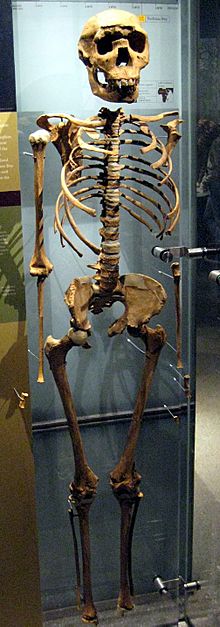Turkana boy facts for kids
 |
|
| Catalog number | KNM-WT 15000 |
|---|---|
| Common name | Turkana Boy |
| Species | Tentatively assigned Homo ergaster |
| Age | 1.6 mya |
| Place discovered | Lake Turkana, Kenya |
| Date discovered | 1984 |
| Discovered by | Kamoya Kimeu/Richard Leakey |
Turkana Boy, also called Nariokotome Boy, is a very important fossil known as KNM-WT 15000. It's almost a full skeleton of an early human relative (a hominid) who lived about 1.5 million years ago. He died near what is now Lake Turkana in northwest Kenya. This fossil is special because it's the most complete early human skeleton ever found!
Scientists first thought he was a type of Homo erectus. After a lot of discussion, they decided he was actually a Homo ergaster.
When he died, Turkana Boy was likely around 8 years old. Some earlier ideas suggested he was between 7 and 15 years old. Scientists first thought he would have grown to be very tall, about 1.85 meters (6 feet 1 inch). But new research suggests he would have been closer to 1.63 meters (5 feet 4 inches) as an adult. His growth was different from how modern humans grow. He probably had a shorter and smaller growth spurt during his teenage years.
The skeleton was found in 1984 by Kamoya Kimeu. He was part of a team led by Richard Leakey. They found the fossil at Nariokotome, which is close to Lake Turkana in northwest Kenya.
How Old Was Turkana Boy?
Scientists know Turkana Boy was a male because of the shape of his pelvis (hip bones). Figuring out his exact age when he died is tricky. It depends on whether scientists look at his teeth or his bones. It also depends on if they compare his growth to modern humans or to chimpanzees.
Modern humans have a big growth spurt when they are teenagers. Chimpanzees do not have this kind of growth spurt. At first, scientists thought early humans grew like us. But newer fossils show that early Homo species might not have had such a strong teenage growth spurt. This changes how scientists guess his age and how tall he would have been as an adult.
What Did Turkana Boy Look Like?
Turkana Boy's pelvis was narrower than that of modern humans. This might have helped him run more efficiently. Running well could have helped him hunt small animals or escape from dangerous predators. He was also quite tall, which would have helped his body cool down in the hot African climate.
He might have had thinner body hair to help him stay cool. Early humans likely lost a lot of their body hair when they started living in open savanna areas. In equatorial Africa, modern humans developed less body hair about one million years ago.
Turkana Boy's skeleton still had features that are not seen in H. sapiens (modern humans). For example, he had a low, sloping forehead and strong brow ridges above his eyes. He also did not have a chin. His arms were a little longer compared to his body than ours are. Unlike apes, Turkana Boy had a nose that stuck out from his face.
Images for kids
See also
 In Spanish: Niño de Nariokotome para niños
In Spanish: Niño de Nariokotome para niños



